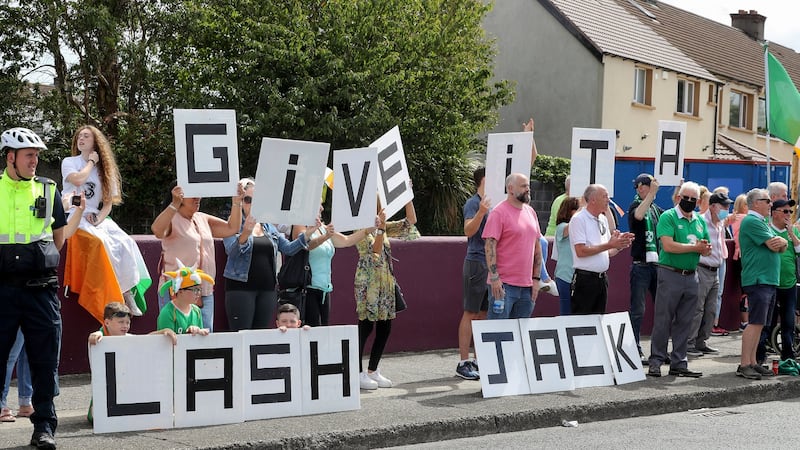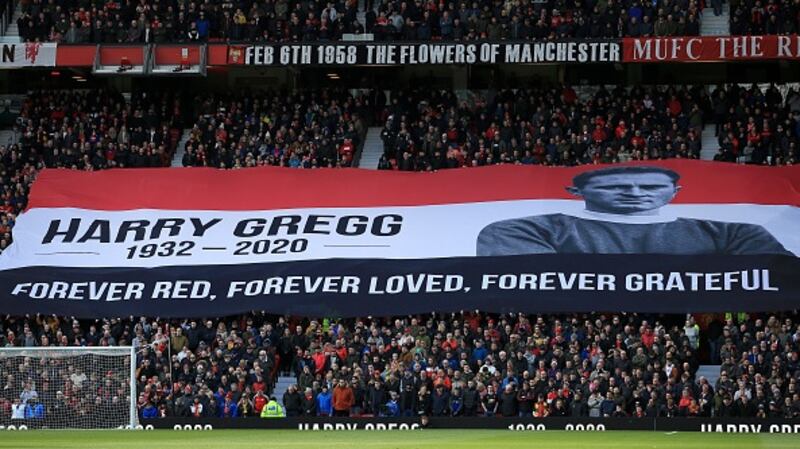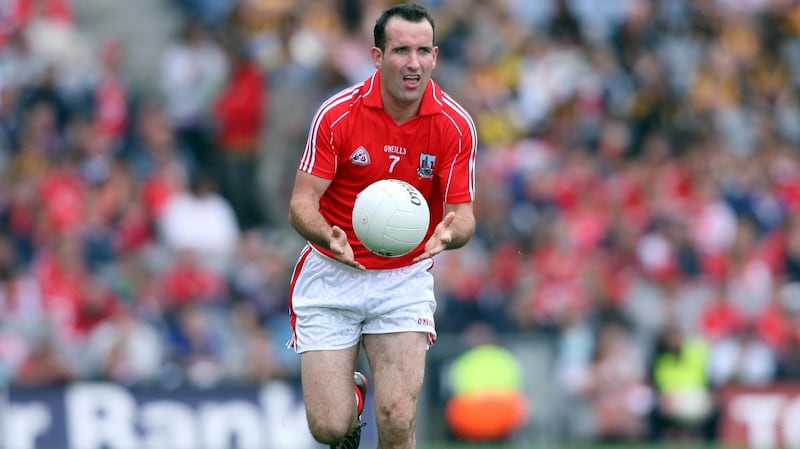The two men could hardly have been more different, other than, in their own way, each became footballing deity.
Diego Maradona's death, at the age of 60, in November was greeted with huge crowds lining the streets following a lying in state at the presidential palace in Buenos Aires. The people of Ballina, where Jack Charlton became an adopted son, lined the banks of the River Moy to pay their own tribute on the death, at age 85, of the former Ireland soccer manager in July.
"I have lost a great friend and the world has lost a legend . . . . one day I hope we can play football together in heaven," said Pele on Maradona's death, due to cardiac arrest. "He leaves us but does not leave, because Diego is eternal," avowed Lionel Messi.
The French sports newspaper “L’Equipe” ran a three word banner headline, “DIEU EST MORTE” - “GOD IS DEAD” - to proclaim his death and the passing of a player generally considered one of the greatest players of all time, although one who also had a darker side with addiction to alcohol and drugs an issue that troubled the Argentine throughout his adult life.
Two photographs came to epitomise Maradona. One is of him kissing the World Cup, after he led them to victory in Mexico in 1986. The other is of Maradona - with, quite literally, a helping hand - rising above England goalkeeper Peter Shilton to punch the ball home for a goal which controversially stood during the quarter-final. Later in that same match, the man known as "El Pibe de Ora" - "The Golden Kid" - would produce one of the outstanding individual goals of any World Cup.
"He was someone who touched the sky with his hands but never took his feet off the ground"
The controversy and accusations of cheating didn’t bring any remorse from Maradona, who said of the goal that it was “a little with the head of Maradona and a little with the hand of God.”
That 1986 World Cup win would prove to be the high point of a footballing career for a boy born in absolute poverty in the slums of Lanús, just south of Buenos Aires. Football provided a pathway out of that poverty, his left foot providing a wand for his footballing wizardry which took him around the globe. His clubs numbered Argentinos Juniors, Boca Juniors, Barcelona, Napoli, Sevilla, Newell's Old Boys and, finally, back to finish at Boca Juniors in a playing career that lasted from 1976 to 1997. Maradona scored 259 goals in 491 club matches.
It was at Napoli that Maradona - short and stocky, at 5-ft 5-in - played his best club football, joining the Italian club from Barcelona and leading them to their first league titles in 1987 and 1990 and to the Uefa Cup in 1989. Shortly after his death, the ground in Naples was renamed in his memory.
“He was someone who touched the sky with his hands but never took his feet off the ground,” said Argentinian president Fernández of the player who was idolised in his homeland.
In Ballina, a mural on a wall pays homage to Charlton. A keen fisherman, the Co Mayo town became a second home to Charlton, and the man known as "Big Jack" - an imposing presence, his 6 ft 2 inch physique matched by a unique charm - was mourned as a national sporting idol in his native England. There he won a World Cup medal alongside his brother Bobby in 1966, but also in his adopted Ireland, where he became the country's first foreign born manager and one who guided Ireland to the quarter-finals of the 1990 World Cup in Italy.
Charlton was born in Ashington in Northumbria and, although his father was a coal miner, his mother was sister to four brothers who played professionally and was cousin to the legendary striker Jackie Milburn.
It was as a tough, no-nonsense defender that Charlton earned his keep, joining Leeds United on trial as a 15-year-old and playing with the Yorkshire club from 1952 until he finished his career in 1973.
In his playing career with Leeds, he played 629 times and scored 73 goals which, for a centre-half, was a more than decent return given his main attribute was stopping players at the other end of the pitch. With Leeds, he won the First Division title in 1969 and the FA Cup in 1972 and two Fairs Cups (which became the Uefa Cup) in 1968 and 1971.
Gentleman
His highest honour as a player was unquestionably playing for England in the World Cup on home turf in 1966, where Big Jack was a rock in defence as the Alf Ramsey managed team safely negotiated the group stages before beating in turn Argentina in the quarter-finals, Portugal in the semi-final and West Germany in the final, where Geoff Hurst scored two goals in extra-time for a 4-2 win. He later admitted: "There's a picture of me at the end down on my knees. I don't remember if I was saying a prayer or just knackered!"

As a manager, Charlton cut his teeth at club level with Middlesbrough, Sheffield Wednesday and Newcastle United. One of his quirks is that Charlton never signed a contract relying instead on a gentleman's agreement that he would have no interference from boards and that he could have time off for fishing and shooting.
An approach from the FAI in December 1985 would prove life-changing for Charlton, and determined a seismic shift for the Irish soccer team’s fortunes. His “Put ‘em under pressure” philosophy of play became a catchphrase and a song, but it was a style of play - not allowing the opposition time on the ball - that reaped rewards with Charlton. He would be granted honorary citizenship, leading Ireland to Euro 1988 (including a famous win over England) and subsequently to World Cup appearances at Italia 90 and USA 94.
"Under Jack we were mostly ramshackle and part of what made us tick was the disorganization and the joy we got from pretending to the world that we weren't to be taken seriously," wrote Niall Quinn in his autobiography.
Charlton's approach, of having his team work hard on the field and have fun off it, caught the heart and soul of the nation. "He changed everything about Irish football, he came in and changed that mentality . . . . his legacy within Ireland is absolutely huge," said Ray Houghton, one of those who provided a heartbeat of Charlton's teams on the biggest stages.
Rest in Peace
Pat Smullen 1977-2020
Smullen - from Rhode in Co Offaly - was first introduced to the joys of horse-riding as a 13-year-old. “It really is true what they say about being bitten by the bug. I knew the second I put my leg over the pony that this is what I wanted to do,” he recalled of that start to what would become a magnificent career.

A nine-times champion jockey on the flat in Ireland, Smullen's reputation was further embellished by big wins abroad. As stable jockey to trainer Dermot Weld for almost 20 years, Smullen won nine Irish Classics and among his other great successes was in guiding the Aga Khan's colt Harzand to victory in the 2016 Derby at Epsom.
Smullen's career started as an apprentice to Tom Lacey and he was twice champion apprentice but it was on moving to Weld's yard in 1999 - to succeed Michael Kinane as stable jockey - that things really took off. He was champion jokey for the first time in 2000 and, in 2001, he and horse Vinnie Roe, owned by film director Jim Sheridan, won the first of a record four Irish St Legers.
In 2002, Smullen won his first English Classic, the 2,000 Guineas on Refuse to Bend, while later that year he showcased his brilliance in riding Dress To Thrill in the Matriarch Stakes in Los Angeles.
Diagnosed with pancreatic cancer in 2018, Smullen - who raised over €2.5 million in fundraising to aid Cancer Trials Ireland - fought a brave fight but sadly passed away, aged 43, in September.
Kobe Bryant 1978-2020
Bryant, who was born in Philadelphia but spent much of his childhood in Italy where his father finished out his professional basketball career before returning home to the United States, was drafted by the Charlotte Hornets but immediately drafted to the Los Angeles Lakers as a 17-year-old and would enjoy a magnificent playing career that included five NBA championship titles and two Olympic gold medals.
Tragically, Bryant was killed in January - along with his teenage daughter and seven other occupants - when the Sikorsky S-76 helicopter they were travelling in crashed into mountains outside Los Angeles in heavy fog.
Regarded as one of basketball's great players, Bryant was primarily a shooting guard and was noted for his fall-away jump shot and, while also noted for his defensive duties, achieved numerous scoring feats through his career, including scoring 81 points in one game (against the Toronto Raptors in 2006). Phil Jackson, the Lakers coach at the time, remarked: "I've seen some remarkable games but I've never seen one like that before."
In all, Bryant hit 33,643 points - a record for a guard - in his NBA career.
Bryant was on the LA Lakers team that also included Shaquille O’Neal which won three consecutive championships from 2000 to 2002 but there was a falling out between the two following a loss in the 2004 NBA finals and O’Neal was traded to the Miami Heat. Bryant became the cornerstone of the team which led the Lakers to consecutive championships in 2009 and 2010, winning the Most Valuable Player award on both occasions.
Úna O’Connor 1938-2020
Regarded as one of the camogie’s finest ever players, O’Connor - a native of Marino - won 13 All-Ireland championship medals with Dublin and was named as left-half forward on the Team of the Century in 2004.
The youngest of eight children, O’Connor was a teenage prodigy: she won her first All-Ireland medal in 1953 as a 15-year-old when she scored three goals in the final against Tipperary. Remarkably, by her 18th birthday, she had three gold Celtic Cross medals after Dublin successfully defended their titles in 1954 and 1955.
After Antrim won in 1956, Dublin’s return to winning ways in 1957 led to a dominant period which resulted in 10 straight All-Ireland wins. O’Connor was out of favour for the 1957 final but, with Dublin struggling to overcome defending champions Antrim, she was introduced as a substitute and transformed the game, scoring the winning goal to collect her fourth All-Ireland medal.
O’Connor was part of each of Dublin’s All-Ireland winning teams in that 10 year dominance from 1957 to 1966 and captained the team in both 1963 and 1964. A member of the Celtic club in Marino, she also won 10 Dublin championships and an All-Ireland club in 1964.
Harry Gregg 1932-2020
A goalkeeper of some renown, both with Manchester United and Northern Ireland, Gregg's legacy had much to do with his heroic actions during the Munich air disaster of 1958 when he repeatedly returned to the blazing wreckage to rescue people.
Gregg and his Manchester United team-mates were on a flight back from Belgrade which failed to clear the snowy runway after refuelling in Munich.

With the plane ablaze and fears that further explosions were possible, Gregg ignored the general order to run for cover and returned a number of times to the wreckage to pull out a number of fellow passengers: among those he saved were United players Albert Scanlon, Ray Wood, Jackie Blanchflower, Bobby Charlton and Dennis Viollet who while unconscious he pulled away by his trouser waistband. Eight players were among the 23 fatal casualties of the disaster.
"Bravery is one thing but what Harry did was about more than bravery, it was about goodness," George Best would recall of Gregg's actions.
Remarkably, Gregg was back playing less than a fortnight after the crash and the team which became known as Busby’s Babes went on to reach the 1958 FA Cup final (losing to Bolton Wanderers), after which it emerged the headaches he was suffering were caused by a fractured skull sustained in an earlier cup match.
Gregg’s professional career in England started with Doncaster Rovers who signed him from Coleraine: he played 94 times for the Rovers before being signed by United in 1957 and he played 210 times for the Old Trafford club in a nine-year stint which was hampered by a shoulder injury in the later years. He finished out his club career at Stoke City.
With Northern Ireland, the high point was in reaching the World Cup finals in Sweden in 1958 where he earned the accolade as the goalkeeper of the tournament.
Kieran O’Connor 1979-2020

"He just had speed, that competitive edge that's essential for a good corner-back. He'd be cocky enough when it came to it. He could burst up the field and get the odd score but it was the speed and aggression that stood to him. He had those qualities in abundance and that's what made him," is how former Cork manager Conor Counihan remembered O'Connor as a footballer.
O’Connor - who passed away in July after battling a rare form of bone cancer since 2017 - was a tough, uncompromising defender but with a flair to back up attacks who played for Cork from 2004 until 2011.
He first made his senior debut for the Rebels under Billy Morgan's management in 2004 and the Aghada man won three Munster senior championships in his inter-county career; and, having started both the 2007 and 2009 All-Ireland finals, when Cork lost on each occasion to Kerry, O'Connor was part of the squad that finally got over the line in winning the 2010 All-Ireland.












